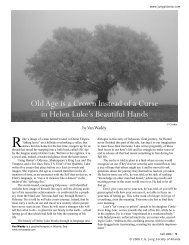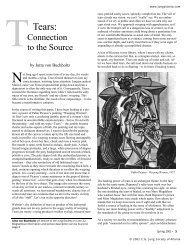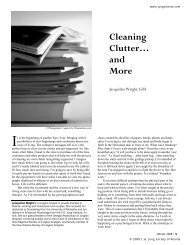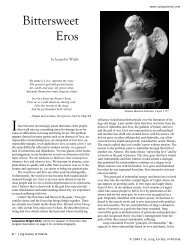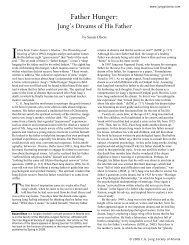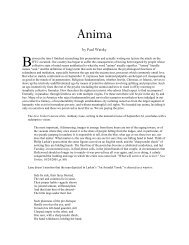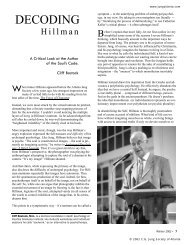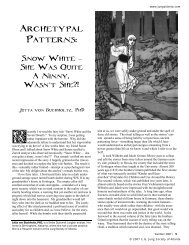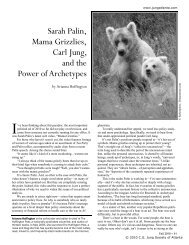Hermes and the Creation of Space - C.G. Jung Society of Atlanta
Hermes and the Creation of Space - C.G. Jung Society of Atlanta
Hermes and the Creation of Space - C.G. Jung Society of Atlanta
You also want an ePaper? Increase the reach of your titles
YUMPU automatically turns print PDFs into web optimized ePapers that Google loves.
Brown draws an important distinction, too, when he points out that <strong>Hermes</strong> is not primarily a<br />
fertility god. The phallos on his statue is not a signifier <strong>of</strong> male procreativity <strong>and</strong> sexual prowess.<br />
Brown associates <strong>the</strong> phallos with his perception that <strong>Hermes</strong> is fundamentally a magician: "The<br />
phallus is so closely identified with magic in Roman religion that <strong>the</strong> word fascinum, meaning<br />
'enchantment,' 'witchcraft' (cf. 'fascinate'), is one <strong>of</strong> <strong>the</strong> st<strong>and</strong>ard Latin terms for <strong>the</strong> phallus; no<br />
better evidence could be found for <strong>the</strong> appropriateness <strong>of</strong> <strong>the</strong> emblem for <strong>Hermes</strong> as magician.<br />
When Greek craftsmen hung images <strong>of</strong> ithyphallic demons over <strong>the</strong>ir workshops, it is clear that to<br />
<strong>the</strong>m <strong>the</strong> phallus symbolized not fertility but magic skill at craftsmanship" (p. 37). I would agree<br />
with Brown but place <strong>the</strong> accent on creativity - <strong>the</strong> Creative itself as fascinosum, following Aniela<br />
Jaffe's interpretation <strong>of</strong> <strong>Jung</strong>'s famous childhood dream <strong>of</strong> <strong>the</strong> underground phallus - ra<strong>the</strong>r than on<br />
magic, although <strong>the</strong> two can easily be associated. Creative people have <strong>of</strong>ten seem especially<br />
potent <strong>and</strong> magical, <strong>and</strong> <strong>the</strong>ir talents can be awesome <strong>and</strong> numinous. Creativity is magical, <strong>of</strong> <strong>the</strong><br />
self <strong>and</strong> not <strong>of</strong> <strong>the</strong> ego.<br />
The phallos on <strong>the</strong> <strong>Hermes</strong> monument, <strong>the</strong>n, grounds this image in instinct, not in <strong>the</strong> sexual<br />
instinct as such however but in <strong>the</strong> instinct <strong>of</strong> creativity.<br />
<strong>Hermes</strong> as a "factor" in <strong>the</strong> psyche<br />
In my underst<strong>and</strong>ing <strong>of</strong> <strong>Jung</strong>'s mature thought, a major mythic figure like a god represents a<br />
psychological factor that embraces an archetype <strong>and</strong> an instinct. The archetype, rooted ultimately<br />
in spirit, is represented in <strong>the</strong> psyche by an image <strong>and</strong> is a mental, <strong>and</strong> <strong>of</strong>ten a cognitive, object or<br />
process; <strong>the</strong> instinct, rooted in <strong>the</strong> material body, is experienced in <strong>the</strong> psyche as an urge, a drive, a<br />
force compelling one to do something. In <strong>the</strong> psychological factor that a god symbolizes, instinct<br />
supplies <strong>the</strong> drive <strong>and</strong> <strong>the</strong> dynamic force, while image orients <strong>and</strong> directs it. Instinct <strong>and</strong> archetype<br />
are wedded in <strong>the</strong> psyche, <strong>and</strong> a god is a representation <strong>of</strong> this conjunction.<br />
To summarize what I have said so far about <strong>the</strong> Greek god <strong>Hermes</strong>: in <strong>Hermes</strong> we have a figure<br />
who signifies a union between an innate tendency on <strong>the</strong> part <strong>of</strong> <strong>the</strong> psyche to create boundaries<br />
<strong>and</strong> define spaces, to etch lines in <strong>the</strong> panes <strong>of</strong> perception (an archetypal process), <strong>and</strong> <strong>the</strong> instinct<br />
<strong>of</strong> creativity. It is this particular combination <strong>of</strong> archetype <strong>and</strong> instinct that makes <strong>Hermes</strong> so<br />
interesting psychologically. He signifies <strong>the</strong> creative instinct at work in <strong>the</strong> psyche in a particular<br />
way. A specific type <strong>of</strong> creator god, he is <strong>the</strong> creator <strong>of</strong> new spaces. It is in <strong>the</strong> creation <strong>of</strong> new<br />
spaces, novel spaces, inventive spaces, especially psychologically subtle spaces that <strong>Hermes</strong><br />
shows his special nature <strong>and</strong> genius. Trickster <strong>and</strong> magician are suitable epi<strong>the</strong>ts, for <strong>of</strong>ten <strong>the</strong>se<br />
are secret spaces <strong>of</strong> subtle interiority.<br />
New <strong>Space</strong>s<br />
When you draw a line on a blank page, you create new space. And you also destroy or transform<br />
an already existing space. In this simple act, destruction <strong>and</strong> creation take place <strong>and</strong> a new space is<br />
opened up. A new inside/outside possibility has been created, as when some people are elected to<br />
form a small group within a larger group. Yahweh, ano<strong>the</strong>r creator god, resembles <strong>Hermes</strong> in this<br />
respect; he too creates space, divides <strong>and</strong> sets boundaries, <strong>and</strong> selects a people from among all <strong>the</strong><br />
peoples <strong>of</strong> <strong>the</strong> earth to be his chosen.<br />
Some spaces have magical properties, which unite inside <strong>and</strong> outside in a surprising way, like <strong>the</strong><br />
Moebius strip. Boundaries are not what <strong>the</strong>y seem. Even carefully guarded <strong>and</strong> maintained, <strong>the</strong>y<br />
are both real <strong>and</strong> irreal. It is as though <strong>the</strong> boundary line is a space itself, which can open into a<br />
new space <strong>and</strong> which is permeable to <strong>the</strong> o<strong>the</strong>r spaces. This is <strong>Hermes</strong> space, a liminal space.<br />
Boundaries, we find again <strong>and</strong> again, both separate <strong>and</strong> unite spaces.




